The Mindful
It was three in the morning and Edward was lying on his back with his head dangling off the wrong end of his mattress. He was holding his phone upside down in front of his face so that it was correct from his point of view. Two months earlier, he had been laid off from his job as a customer service representative, and he hadn’t slept well since. He should have been hunting for jobs right now, but his attention span was not up to the challenge.
Instead of looking for jobs, he was surfing random web pages and watching obscure videos. From tea ceremonies to trepanation, from 80’s punk bands to black holes. He had just started consuming a juicy article about Japanese whaling vessels when he saw an ad at the top of his phone: “Edward Sleater: Free Meditation Class Tomorrow Near You.” He briefly wondered how they got his name for the ad and then considered the offer.
Edward had read about meditation dozens of times. He heard that “top performers” meditated as part of their daily routines. He pictured these same top performers waking up at 4 a.m. and journaling their hopes and dreams while drinking vegetable smoothies. What did that have to do with him? He felt silly whenever he tried meditation. What exactly was supposed to happen? He always gave up and went back to his phone. Still, something intrigued him about this ad and his calendar was regrettably wide open. The course was located down the street from him at a popular Chinese restaurant called Sang Ying. Edward lived just outside of Chinatown. The class was tomorrow morning at 9 a.m., so he set three alarms and fell fast asleep.
The next morning, Edward left his building and turned left at the bottom of the stairs towards Chinatown. Within two blocks, he was overcome by the familiar smells of the fish vendors. He weaved along the narrow sidewalk and soon stood at the entrance beneath the overly large Sang Ying sign. He paused to admire the formal dark wood doors, then stepped forward and pulled open the right one. It revealed a tiny dark foyer and a steep wooden staircase. He thumped up the stairs into the otherwise quiet dining room.
There were no windows in the dining room, but the plentiful gold leaf made it appear noticeably brighter than the stairwell. In the back of the restaurant, several of the round dining tables had been removed and replaced with about fifteen padded folding chairs facing an old-fashioned projector screen.
Edward sat down in the back row. He was the only person sitting in any of the chairs. He glanced at his phone and saw it was already five minutes past nine. A few minutes later he heard a crash from the kitchen. Twenty seconds after that, an old man shuffled out from behind the projection screen. He was a short, elderly, Chinese man perhaps in his mid-eighties. It looked like he was wearing pajamas. He was bald but had a long wispy beard that was shock white. His eyes were also white and they were clouded over. He was blind.
“Welcome to my Meditation Class. I will be your teacher. My name is Kurt,” the man said in perfect English. In fact, he had the deep pitch of a radio announcer and the neutral accent of a national news anchor. It was very disconcerting relative to his appearance.
Kurt continued, “First a bit of housekeeping. If you are hungry at any point in the class, flag down a server. The restrooms are in the back. If you have any questions please save them until the end. Ready?”
Edward looked left and right. No one else had shown up to take the course. He waited fore a few beats and then softly said “Yes.”
“Excellent,” said Kurt. “Now, where do I begin?” As if to answer his question, an image burst onto the screen. There was no discernable projector or laptop, but a bright and clear image appeared that depicted a globe and a brain and two arrows:
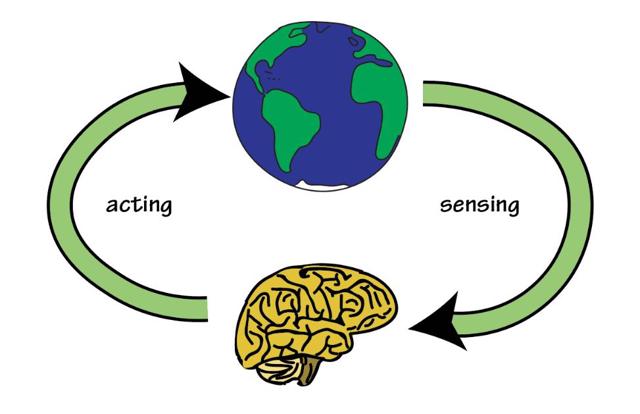
“Your brain does many things. Two primary ones are sensing the world and taking action in the world. For example, suppose you see some fine-looking dumplings on one of the food carts and decide to raise your hand to order them. You sensed the dumpling visually and through smell. You took action by raising your hand and eventually by eating it. You sensed, then acted.
“We are constantly performing these two complementary functions, sensing and acting. Senses include the big five: vision, hearing, touch, taste, and smell. Less obvious senses include proprioception, your ability to tell where your body is in 3-D space, or the sensation of temperature.”
Edward again looked to his left and right. He was still the only one attending the class. Kurt was carefully scanning the room as he spoke. Did he think it was a full house? Edward considered Kurt’s opening remarks about sensing and acting. He wondered, was considering something an action? How about wondering?
Without any movement from Kurt the screen switched to a new image:
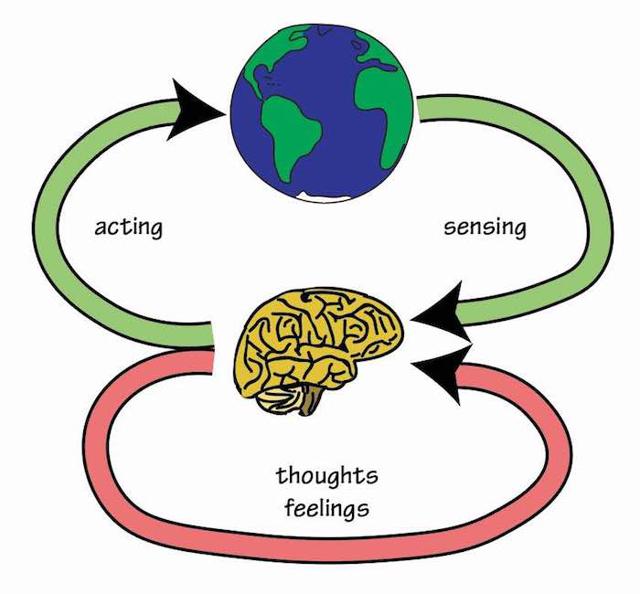
As before, there were two green arrows. One labeled sensing went from the world to the brain. And one labeled acting went from the brain to the world. Now, however, there was a new red arrow. It connected the brain with itself and was labeled thoughts and feelings.
Edward supposed that “considering” was part of this red arrow. Something he did internally.
Kurt continued, “Aside from actions, our brain generates thoughts and feelings which have no immediate impact on the world. Simply thinking, ‘I’m a bit hungry, perhaps I should order some dumplings,’ does not itself cause any change in the world. Things in the world do not change until you take action, until you order the dumplings and eat them.
“Does this mean thoughts and feelings have no purpose? Of course not. They are crucially important as we will see. They often influence our actions in the future. It’s just necessary to realize they themselves are not actions.”
Edward agreed with what Kurt was saying. There was a difference between something going on only in his head compared to events and actions taking place in the world. In his case, lots of ideas swirled around in his head at all times and only a small fraction led to some form of action. Was Kurt trying to say these private thoughts were pointless? Edward didn’t feel they were. Come to think of it, his brain was also part of the world, wasn’t it?
Meanwhile, Edward realized he was hearing a server pushing one of the food carts off to his right. He smelled dumplings. He raised his right hand and the server gave him a plate containing three juicy dumplings. Edward placed the plate on his lap and accepted the chopsticks and napkin she handed him next.
Edward longed for some soy sauce but he was reluctant to flag down the server since she was headed back to the kitchen. So he scarfed down his dumplings. They were divine. He looked up from his plate to see a new slide:
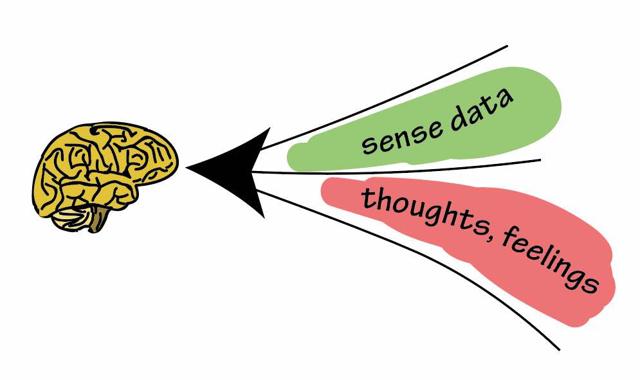
It seemed like a simpler version of the previous slide. Instead of arrows forming loops there was a single arrow pointing to the brain. The arrow was divided into two regions. The green color again indicated our external senses while the red indicated internal thoughts and feelings. So both were entering the brain.
Kurt began, “Our brains are magnificently vast in capacity, nonetheless even they only have a finite amount of resources. If we are focused 100% on the external world, we can’t, at the same time, be very introspective. Meanwhile, if we turn our gaze fully inward, we aren’t going to be able to observe the world as intently. There is a trade-off between looking outward and looking inward.
“Imagine threading the eye of a needle, or hammering a nail, something that requires your full attention. In those moments your mind won’t wander, or if it does you are liable to botch the task. If you are doing it right your eyes and brain are focused on the external world for those few key moments.
“At the other extreme, have you ever been so lost in thought that you enter a room without remembering why you came into the room in the first place? Your body was on auto-pilot while your thoughts were wandering.
“Let’s look more carefully at the various possible states, and see how each is internally or externally focused.”
Edward had finished his dumplings. He placed his small plate under his seat with the chopsticks and napkin on top. When he lifted his head a new image was on the screen:

The image was the same as the last one, but without text labels. The red and green portions of the incoming arrow were about the same size.
“Let’s call this state normal. Your sense data is coming in as green and your internal thoughts and feelings are red. Both are occurring with similar frequency, neither is dominating.
“This person is paying attention to the world, but they entertain thoughts and feeling as they arise. There is no preference assigned to either type of interaction. This is a perfectly reasonable and functional state of mind, it’s how many of us operate most of the time.”
Edward figured this balanced state was where he was right now. Listening closely to Kurt’s words, but still having internal thoughts as well. A new image appeared:

In this image, red dominated the input arrow. Green was just a small sliver.
“We have all found ourselves lost in thought. For example, when riding a train you might stare out the window and think about work, your love life, or something you read earlier that day. You are still aware of the wider world somewhat. If something alarming or threatening happened you would notice, but your dominant state of mind is about what’s going on inside your head.”
Edward related to this slide very much. He often rode public transportation and would generally “zone out” while riding, to the point where he occasionally missed his stop. In the next image the incoming arrow was 100% red:

“There are two times you might experience this state: when you are asleep, which is perfectly normal, or when you are awake, which is cause for alarm. “When you dream your mind is almost fully disconnected from the world. You can walk in your dream while your legs aren’t actually moving. You can see things in your dream that really aren’t in the room.
“However some people slip into this state when awake, due to extreme tiredness, mental illness, or drug use. In that case, they are disconnected from reality and take action without understanding what is actually going on. It’s a very dangerous situation for them and those around them.
In the final slide the incoming arrow was 100% green:

“Finally the state we came here to talk about. The opposite of a dream state is mindfulness. In this state, you are completely absorbed in the sense-data streaming into your brain. You are completely absorbed with what is happening externally in the world.
“Imagine walking outside without realizing it was getting dark. You exit your home or work and look up to see a magnificent sunset. Vivid red and violet sweep across your field of view and a few wispy clouds float by in the foreground. You soak in the scene thinking of nothing except the beauty in front of you. At that moment you are mindful.
“Now imagine conjuring that same feeling of peace and quiet reverence in life’s most mundane situations. Sitting alone in your living room, waiting at a red light, even doing chores. This is one benefit of practicing mindfulness.
“However the goal of meditation is not mindfulness, but mindfulness is the state we will purposefully return to while meditating. It’s very easy to conclude that mindfulness is ‘good’ and therefore other states are ‘bad’. This is not the case and this confusion can easily hinder your meditation practice.
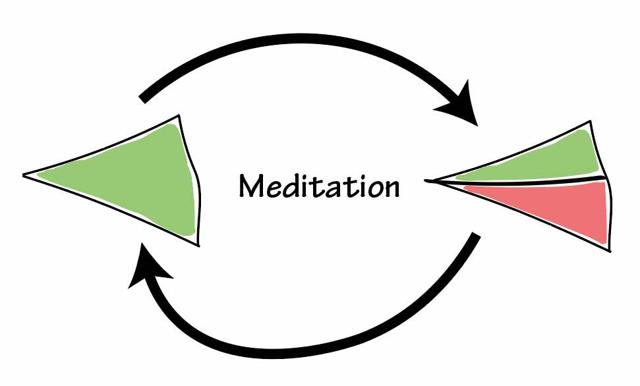
The meditation cycle
The next slide showed two states. The full green shape on the left was the state Kurt had just been discussing, “mindfulness”, and the mixed red and green triangle on the right Edward remembered was “normal”. So meditation he gathered was cycling between the normal and mindful states.
“Finally we can explain meditation. Meditation is purposefully putting yourself into the mindful state, and then returning to that state whenever your attention wanders to your internal thoughts and feelings.
“Note that mindfulness is not the goal of meditation. The goal of meditation is to non-judgmentally and gently enter the mindful state whenever you realize you’ve exited it. And believe me, you will exit the mindful state, sometimes within seconds! As long as you are purposefully transitioning into a mindful state, it doesn’t matter how frequently, then you are correctly practicing meditation.
“For example suppose you are meditating and suddenly realize you are lost in thought thinking about something you want to tell a friend. You are effectively drafting a letter in your head. This is perfectly fine. However, once you realize this fact, you should gently but purposefully steer yourself back into a mindful state.
“So you might be asking yourself how does one enter the mindfulness state?”
Edward was asking himself that very question. When he tried meditation before he really wasn’t in any kind of special state. Essentially he just sat there with his eyes closed while thinking. He’s guessing now that he wasn’t really meditating.
Kurt took a few deep breaths before turning his attention to the new slide:
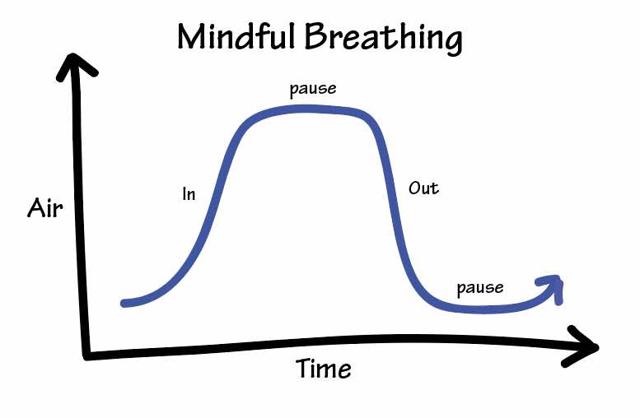
Edward felt like he was going back to kindergarten: a lesson on how to breathe? Although come to think of it he didn’t remember anyone teaching him how to breathe in kindergarten.
“Mindfulness is about paying attention to the present moment, to the sense data streaming in from our eyes, ears, and other senses. We learn to let thoughts and feelings float by, we don’t engage them. If we do engage we learn to recognize that fact and disengage quickly but gently.
“It’s relatively easy to be mindful in situations that demand our full attention. For instance, threading the eye of a needle or driving a car in a tense situation. We are sucked into the present moment without thinking about it. What’s harder is to enter the present moment when nothing much is happening. Thankfully there is one thing that is always happening: we are always breathing.
“We use our breath as a meditation object for four reasons. Firstly it’s always with us. Secondly, no special equipment is required. Thirdly our breath has a nice gentle rhythm whose cycle time is just about the right length. Breathing in and out takes a few seconds. This is a good match for our attention spans. Our breath is challenging to “follow”, but it’s doable. Finally, there is something sacred about our breath because it’s intrinsically bound to what it means to be alive.
Edward took a deep breath. He listened to the sound of the air going into his nose. He paused for a moment and then exhaled again listening to the sound.
“As you can see on the slide there are four phases to every breath. You breathe in, you pause, even if the pause is barely noticeable, then you breathe out, and again you pause before starting over. It’s important to remember these four phases and try to notice them in your own breathing, at least while you are meditating.
“There are various methods to help you “follow” the breath, to pay attention to it. The easiest method is to just listen to the sound of air entering and leaving your nostrils. Another approach is to sense your rib cage as it expands and contracts. Finally, a way that sounds strange but works for many is to sense the air as it passes over the rim of your nostril. It will take practice, however. You can use any method and change methods at any time.
“When you are meditating make a concerted effort to breathe normally. It will be very tempting to take exaggerated breaths because that way they will be easier to follow. One or two exaggerated breaths when starting a round of meditation is fine, it can be a nice calming ritual. In general, however, you should strive to take normal natural breaths. Only natural breathing is sustainable, you don’t want to hyperventilate!
Edward tried taking a normal natural breath. He took a few. He was overcome with the sensation that he was going to have to take over responsibility for his breathing from now on. How did he return breath control to his subconscious?
“As you try to follow your breath your mind will wander. You will remember your car needs to be inspected. You’ll think about something you said carelessly to a loved one. You’ll start writing an angry note to someone in your head.
“Each time you become distracted from your breath simply take note of the distraction. Some people like to label the distraction. They’ll think to themselves that was “worrying” or I was “daydreaming”.
“After optionally assigning a label to the distraction, without judgment, gently guide your attention back to your breath. Remember staying in a mindful state is not the goal. The goal is to gently transition back into that state as many times as necessary. There is no keeping score in mediation. It’s called a “meditation practice” because the entire point is to practice. If you are practicing you will progress, and as you progress you will see benefits both while meditating and throughout your life.”
Edward closed his eyes. He attempted to follow his breath again. This time he took a deep exaggerated breath. He could feel the air streaming in through his nose. He could feel his chest expanding. He paused when finished inhaling. He started a nice relaxing exhalation.
He thought what was the deal with Kurt? Why does an ancient Chinese man speak like Dan Rather? Do I have to pay for those dumplings? If they’re free I’m definitely going to order more food. Where is the girl with the dumpling cart anyway? She was pretty cute. Edward suddenly realized he wasn’t following his breath at all. How many breaths had he missed? He had no idea.
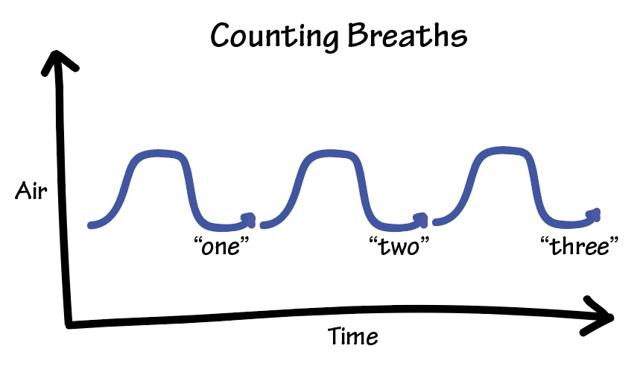
“When meditating it’s sometimes useful to count your breaths. For example when you exhale briefly think “one” and when you exhale the next time think “two”. It is not required that you count your breaths. If you find yourself able to breathe mindful breaths one after the other without counting then by all means do that.
“Sometimes however counting helps create the sensation of progress and eases frustration. If you do count your breaths and reach ten breaths in a row then just start over at one for your next breath. If you lose your count at any point, then without judgment start over at one. As long as you repeatedly turn your attention back to your breath then you are doing it right, however often that is.
“Do not over-focus on counting. For example, if your mind wanders between each count, but you manage to remember the count, this is not useful. If this happens try to complete just one breath mindfully from start to finish. Master that before starting to count breaths. And when you count make sure you are mindful between the counts.
“In order to be successful with your meditation practice, it’s important to adopt a routine that you can consistently maintain. Do not bite off more than you can chew. Sit somewhere comfortable, the lotus position is not necessary and would be counter-productive for most people. Pick a short duration at first, you can always lengthen it over time.
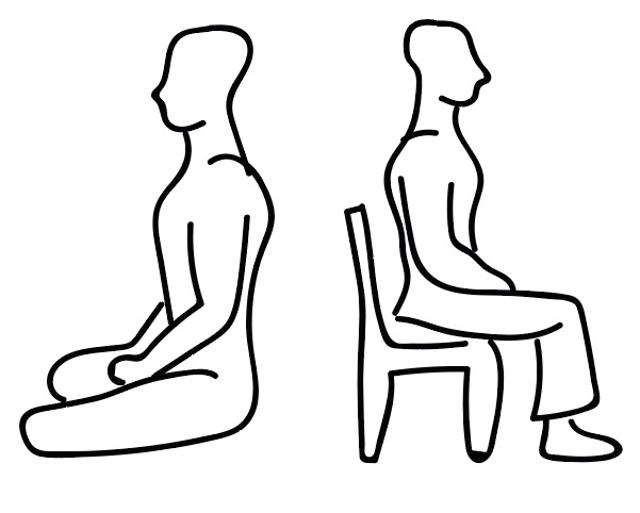
Sit with your back straight.
“I recommend starting with 10 minutes with your eyes closed in a seated position, either on a cushion or on the edge of a chair or couch. The exact position doesn’t matter, but you should be stable, so you aren’t shifting around during the meditation. Your spine should be as upright as possible, one vertebrae stacked on the next. You should never be slumped, hunched, or laying down while meditating. Whenever you fail to follow your breath ask yourself ‘how is my posture?’ before continuing. It’s not uncommon to find you lost your breath because your posture had slumped.
Edward straightened himself up in his chair. Posture was not his strong suit so this might be a challenge for him.
“You can meditate with your eyes open or closed. Closed is best if you are in a protected space and are comfortable having your eyes closed. Open is completely fine as well, and is necessary if you are going to be performing some kind of activity while meditating, for example meditating while walking, driving, gardening, or folding clothes.”
Edward closed his eyes. This made it feel like Kurt was speaking to him from inside his head, that they weren’t sitting inside a Chinese restaurant at all.
“Ideally you want a regular sitting meditation with eyes closed as the heart of your practice. Do it at the same time each day. Then while doing activities you can meditate with your eyes open as ‘bonus’ meditation time. There is no minimum length for a meditation. A short meditation can last just one or two breaths. For example, when you arrive somewhere in the car, take a single mindful breath before opening the door to step out.
“You’ll find that meditation can alter your perceptions about time. If you take meditative breaths at a red light you might find yourself no longer anxiously awaiting for it to turn green, or you might even start wishing it would stay red longer!”
Edward thought about when during the day could he meditate. He ruled out early morning because he just wasn’t a morning person. Lunch was no good because he’d be at work, at least once he was employed again. After dinner seemed like a good idea. And he certainly could find some “bonus” time while riding the subway, if he could resist daydreaming. He’d prefer to keep his eyes open in that case. He would feel a little vulnerable sitting on the subway with his eyes closed.
“Sometimes unpleasant sensations will arise while you are seated. You will feel pains in your legs, back or stomach, itches, or other unwanted disturbances. If it’s not something drastic take each of these as opportunity to examine the feeling before acting on it. What exactly does it feel like? Where is the feeling located? Upon reflection is it as bad as it first seemed? After that. if you need to shift or scratch or even quit meditating for the day by all means do it. However get into the habit of interjecting a calm reasoned questioning point of view before responding with a mindless reaction. Dealing with discomfort and boredom are important parts of practicing meditation
“There are two main obstacles to meditation. One is sitting down, the other is staying seated. Sitting down in the first place takes a certain amount of faith that meditation is going to do you some good. After all if you doubt this, why bother sitting? There is no single person or book that can convince you meditation will benefit you. It’s something you have to decide for yourself based on all the information you’ve acquired during your life.
“Once seated the next obstacle is staying seated. This is harder that you might think. Your first impulse when you start meditating is going to be to jump out of that chair and do something else. Becoming comfortable with sitting takes time and practice. You’re going to be taunted by the thought “get me out of here, I should be doing something else”
“One remedy is to have deep enough belief that the whole process is going to benefit you in the long run. Some people might feel so calm and clear after a single session that the one experience alone compels them to continue. While others might have to press on for weeks or months before they are sure it’s paying off. The other thing is it just takes practice, if you practice you will get better at it.
“It’s best to set a timer ahead of time for how long you intend to practice. Otherwise, you will be tempted to constantly check the elapsed time, and this will intrude into the mediation. So set a timer for 10 minutes, or 30 minutes or whatever length of time you are aiming for. When the timer goes off end the meditation with a good feeling. If you open your eyes and start to get up before the timer has gone off try to sit back down and continue. You haven’t ‘ruined’ the meditation. If you really can’t finish then try it again the next day. If you can never finish in the allotted time perhaps choose a shorter duration. Finishing a mediation through to the end is a small joy you should experience frequently.
You cannot force yourself to remain in a mindful state. This is why during meditation we don’t make the goal to stay in that state. However, by repeatedly gently transitioning into the state, we do learn, subliminally, how to more easily enter and remain in the mindful state. It takes time, but your mind figures it out.
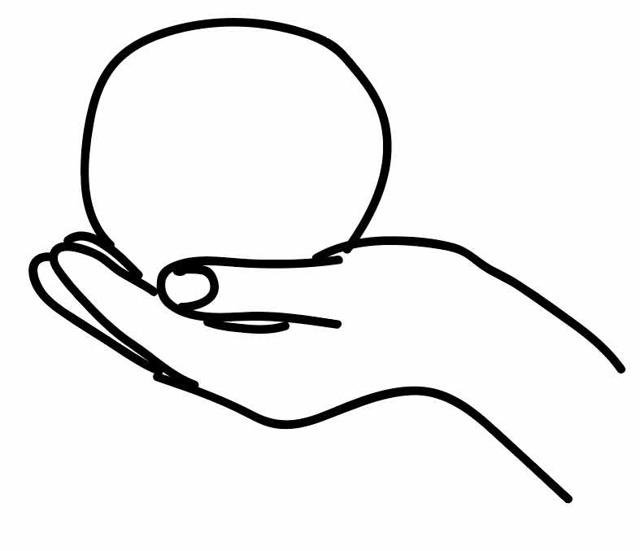
Imagine a large soap bubble.
Being in a mindful state is like carrying a delicate soap bubble. You know it’s going to pop, you just don’t know when. Every second holding that bubble is precious. As you progress the bubble will remain in your hand for longer and longer periods of time. It won’t even be clear that you are doing anything to make it happen, it will just happen.
Edward was jolted slightly when the projected screen went dark, for the first time since the class started. Kurt was calmly appraising the room, not talking at all. Finally, he said, “That’s the end of class. Please put into practice what you’ve learned today. Thank you.” Kurt turned gingerly and walked, perhaps shuffled, back into the kitchen.
Edward looked around. He remembered Kurt had said to save questions until the end, and he had questions, but Kurt was gone. Edward looked directly behind him and saw the lunch crowd was entering the restaurant and servers were springing into action. He pulled out his phone and checked his messages, sat for a bit longer, and then stood up to exit the restaurant.
Later that night after dinner Edward set on the edge of his couch, spine erect, to try some meditation. He set the timer on his phone for ten minutes. He closed his eyes and took a natural breath. As he let the air out of his lungs he thought serenely “one”. This was the start of a new habit for Edward. He continued to practice meditation most days for around ten minutes. He also practiced meditation with his eyes open while waiting in line or riding the subway.
A few weeks later Edward walked by the Sang Ying restaurant. It was closed, completely boarded up. Edward often thought of Kurt and his lessons as he progressed with his meditation practice.
A year to the day after the meditation class he received a text message during dinner: “Meditation question and answer session tomorrow at the restaurant.” A big smile spread across Edward’s face.
Copyright © 2017 Philip Winston